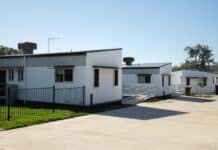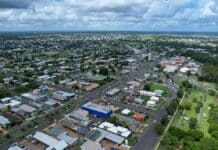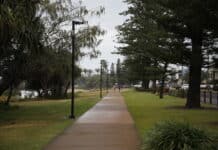
One of the coastline’s newest residential developments Bargara Headlands is looking to set the benchmark for turtle-friendly lighting and support the Reducing Urban Glow project.
Developer Bill Moorhead said he was happy to accept Council’s proposal to place an urban light sensor as part of the project within the development.
He had already proactively been taking steps to ensure the new estate would be seen as a leader in reducing urban glow.
“We want to make Bargara Headlands best practice in lighting,” Mr Moorhead said.
What he said will make his development different was the holistic approach to public and residential lighting.
Potential buyers must first agree to the Bargara Headlands Homeowners Turtle Lighting Management Guidelines.
The “minimum lighting control requirements” include ensuring all external lighting points down and away from the ocean, the use of energy efficient low glow globes, internal lighting to be shaded, such as with blinds at dusk, no floodlights and no residents or visitors to use high beams on their vehicles when driving through the estate.
“Developers, community and people who buy blocks are all working together to reduce urban glow,” he said.
“My theory is we can only do what we can do.
“You start to do things and it catches on.”
While these changes will reduce any potential impacts on nesting turtles along the coastline Mr Moorhead said it was also about a positive lifestyle for future residents.
“Bright blue light is bad for humans as well,” he said.
“We’re saying ‘hey, why can’t we have low glow in an urban environment?
“That’s the key to it.”
Mr Moorhead said some arguments for brighter lighting had already been disproved.
“There’s this perception you need lighting for safety, lighting for cars,” he said.
“It’s all perception, it’s not reality.”
Future residents ready to embrace lighting guidelines
Bargara Headlands marketer Grant Davies said with a number of lots already sold, people were ready to embrace the lighting requirements.
“It’s probably commonsense stuff and everyone agrees,” Mr Davies said.
“We get a selective community of like-minded people.”
The pair feel it will be embraced by future residents as it will also mean power savings.
“Imagine if you could halve your power bill just by helping the environment,” Mr Moorhead said.
Plenty of research has gone in to the lighting requirements, with examples taken from best-practice areas including Florida.
“We’ve tried to make it easy for people to comply,” he said.
“The bottom line is low lumens down and away from the ocean.”
As the developer, Mr Moorhead said he had taken a minimalist approach to public lighting.
This will include no lighting on the new stretch of the Turtle Trail, which will be included as part of stage one.
He is also creating a natural barrier between homes and the oceans.
“I’m madly planting trees on the foreshore at the moment,” he said.
As part of the Reducing Urban Glow project the urban light sensor will be placed within what will become the commercial precinct of the Bargara Headlands development.
It will be one part of the network of sensors that measure light pollution that will soon dot the Bundaberg Region coastline as part of a cooperative strategy to protect nesting turtles.
Bundaberg Regional Council’s Reducing Urban Glow project coordinator Andrew Beckenhaur said the success of the initiative was tied to partnerships with a number of stakeholders.
“Up until now, our collaboration has been primarily with government agencies, academic institutions, and not-for-profits,” Mr Beckenhauer said.
“This is a first in terms of working with business and industry in the region and it’s a really important one because it may help with driving more sustainable development.”
Mr Moorhead said he was keen to have the light sensor installed as soon as possible before any significant development which would give a baseline reading for lighting pollution in the development area.







